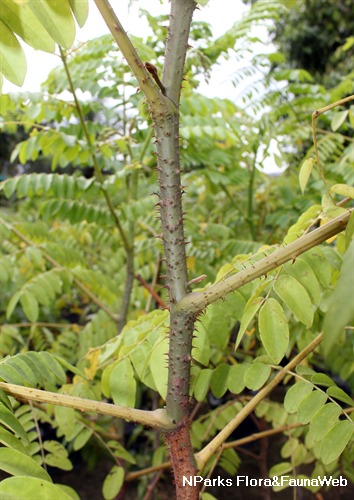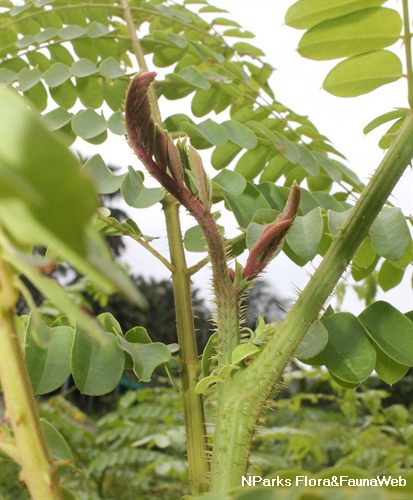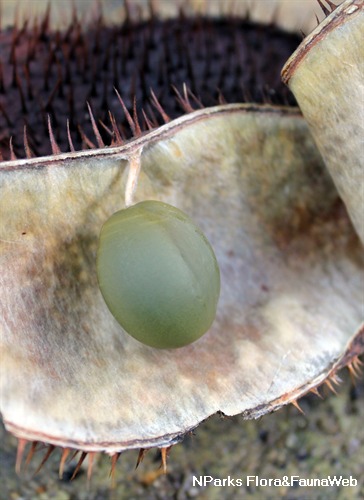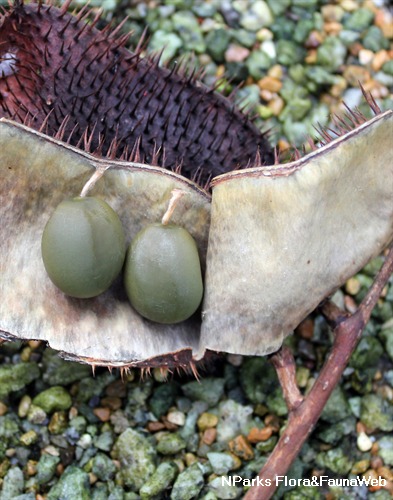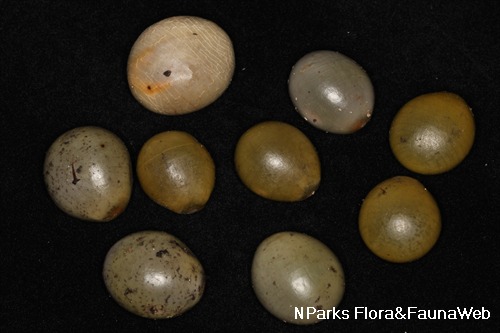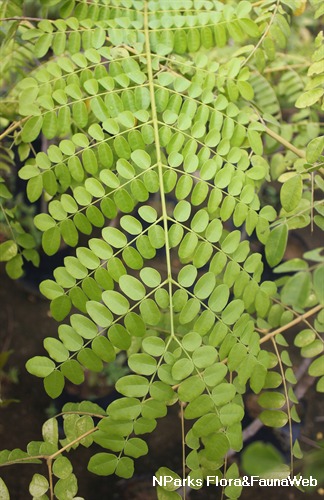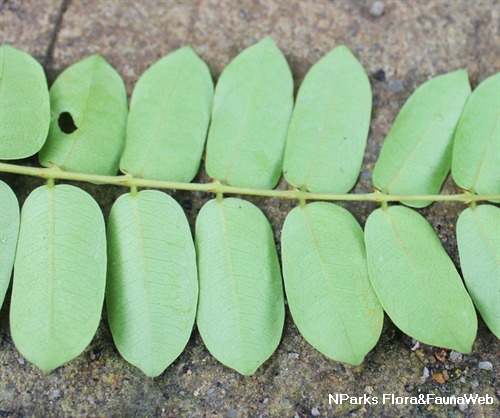.jpg)
Back
Guilandina bonduc (L.) Roxb.
| Family Name: | Fabaceae (Leguminosae) |
| Synonyms: | Caesalpinia bonduc, Caesalpinia bonducella (L.) Fleming |
| Common Name: | Gray Nicker, 刺果苏木 |
Name
Classifications and Characteristics
| Plant Division | Angiosperms (Flowering Seed Plants) (Dicotyledon) |
|---|---|
| Plant Growth Form | Climber, Shrub |
| Lifespan (in Singapore) | Perennial |
| Mode of Nutrition | Autotrophic |
| Plant Shape | Irregular |
| Maximum Height | 15 m |
Biogeography
| Native Distribution | South Thailand through Malaysia, Indonesia, the Philippines, Brunei, Singapore to Papua New Guinea |
|---|---|
| Native Habitat | Terrestrial (Primary Rainforest, Secondary Rainforest, Coastal Forest), Shoreline (Backshore, Sandy Beach) |
| Preferred Climate Zone | Tropical |
| Local Conservation Status | Native to Singapore (Critically Endangered (CR)) |
Description and Ethnobotany
| Growth Form | It is a climber up to 15 m long. |
|---|---|
| Foliage | Its leaves consist of leaflets that are opposite to subopposite, 6–9 pairs per pinnae, egg-shaped or oval-oblong, and 1–6.5 by 0.5–3 cm. |
| Flowers | Its flowers are unisexual and covered with fine hair. Its sepals are 0.7–1 by 0.2–0.3 cm. Its petals are narrowly drop-shaped and 0.7–1 by 0.2–0.3 cm. |
| Fruit | Its pods (fruits) are dehiscent (splitting open to release its seeds), covered with hair, and 6.5–9 by 3.5–4.5 cm. Each fruit has 1 or 2 seeds that are egg-shaped to round, grey, and 1.5–2 cm long. |
| Habitat | It grows in coastal regions, inland forests, and secondary forests up to about 850 m altitude. |
| Associated Fauna | It is the preferred local food plant for the caterpillars of the durian fruit borer (Conogethes punctiferalis), Acrocercops hyphantica, Blastobasis guilandinae, Lacera alope, Marmara guilandinella, and Pococera floridella. |
| Cultivation | It can be propagated by seed or stem cuttings. |
| Etymology | Latin Caesalpinia, commemorating Andrea Caesalpini (1519–1603), Tuscan botanist and physician; bonduc, the Arabic vernacular name for a nut |
| Ethnobotanical Uses | Others: Its seeds are used to soothe stomach disorders and as a mild purgative. Administered in powder form they are considered a febrifuge and tonic. Its leaves are considered carminative, and are used in the treatment of abnormal urination. Its leaves are also an ingredient of a famous cough formula. In Indonesia, its leaves or pounded seeds are employed as an anthelmintic. A decoction of the leaves is prescribed as an antidepressant for mentally disturbed persons. In large doses the plant is believed to be poisonous. A decoction of the leaves is used to treat sinusitis, and of the roots for fatigue. Its leaves and bark are considered emmenagogue, febrifuge and anthelmintic. Its seed has a reputation as a tonic and antipyretic. |
Landscaping Features
| Landscaping | It may be suitable for parks, as a hedge to keep trespassers out. |
|---|---|
| Landscape Uses | General, Parks & Gardens, Small Gardens, Hedge / Screening |
| Usage Hazard - Cons | Spines/Thorns - Stem/Branch, Spines/Thorns - Leaf, Spines/Thorns - Fruit |
Fauna, Pollination and Dispersal
| Fauna Pollination Dispersal Associated Fauna | Moth Food Plant |
|---|---|
| Pollination Method(s) | Biotic (Fauna) |
| Seed or Spore Dispersal | Abiotic |
Plant Care and Propagation
| Light Preference | Full Sun |
|---|---|
| Water Preference | Moderate Water, Little Water |
| Plant Growth Rate | Moderate |
| Rootzone Tolerance | Moist Soils, Well-Drained Soils, Saline Soils / Salt Spray, Fertile Loamy Soils |
| Propagation Method | Seed, Stem Cutting |
Foliar
| Foliage Retention | Evergreen |
|---|---|
| Foliar Type | Compound |
| Foliar Arrangement Along Stem | Alternate |
| Foliar Attachment to Stem | Petiolate |
| Foliar Shape(s) | Non-Palm Foliage |
| Foliar Venation | Pinnate / Net |
| Foliar Margin | Entire |
Floral (Angiosperm)
| Flower & Plant Sexuality | Unisexual Flowers , Dioecious |
| Flower Colour(s) | Yellow / Golden |
|---|
| Flower Grouping | Cluster / Inflorescence |
| Flower Location | Axillary |
Fruit, Seed and Spore
| Mature Fruit Colour(s) | Brown |
|---|---|
| Mature Fruit Texture(s) | Thorny / Spiny |
| Fruit Classification | Simple Fruit |
| Fruit Type |
Image Repository
Others
| Master ID | 31703 |
|---|---|
| Species ID | 6102 |
| Flora Disclaimer | The information in this website has been compiled from reliable sources, such as reference works on medicinal plants. It is not a substitute for medical advice or treatment and NParks does not purport to provide any medical advice. Readers should always consult his/her physician before using or consuming a plant for medicinal purposes. |

